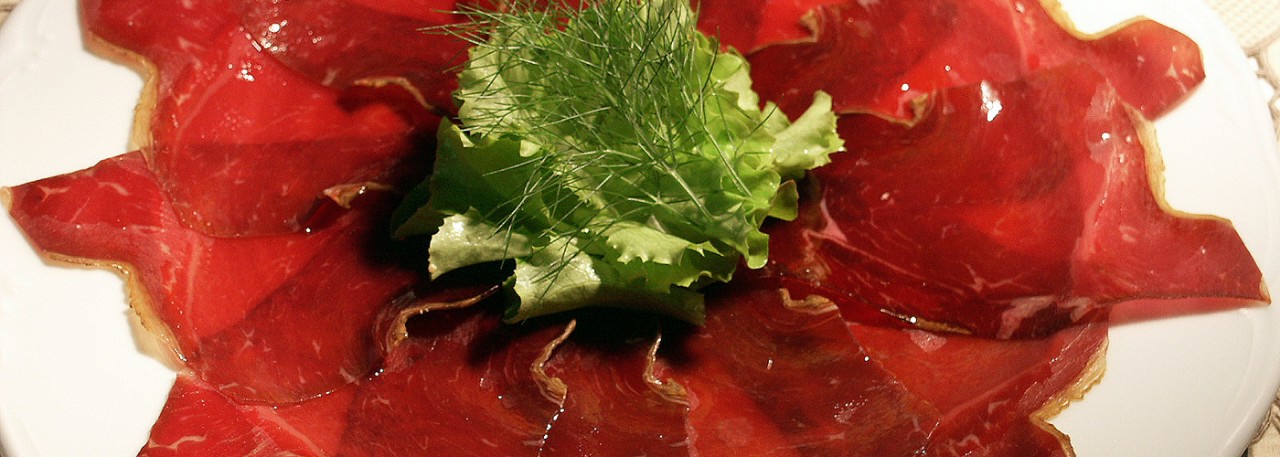.png.transform/rendition-xs/image_image%20(1).png)
Cecina de León PGI
Cuts from the hind quarters of mature cattle (topside, silverside, flank and rump), preferably from breeds indigenous to the region of Castile-Leon, subjected to a salting and maturing period in natural drying sheds for a period of no less than seven months.
Tasting notes
With a flavor characteristic of smoked products, lightly salted, and strengthened by the oak or holm oak wood smoking process, which gives it an individual aroma.
Other notes
Its external aspect is toasted, with a slightly dark brown color. When cut, its color ranges from cherry red to maroon, the latter being particularly noticeable on the edges during the final stages of the maturing process. It does not have a very fibrous consistency, and is quite moist due to the slight marbling of its fat.
Production / Processing method
Cattle to be used for the production of this protected product must be at least five years old, and a minimum live weight of 400 kg (800 lbs).
Once the cuts have been selected (topside, silverside, flank and rump, which can only come from authorized meat establishments, such as slaughterhouses and quartering rooms), the meat is then cured in six stages, with a total minimum duration of seven months, counted from the date on which the meat is salted.
The first stage is to trim the cuts, giving them the proper shape.Then comes the stacking and salting of the pieces, covering them with coarse sea salt for a period of time that depends on the size and characteristics of the cuts, with a minimum of 0.3 days and a maximum of 0.6 days per kilo. This process, carried out at a temperature of between two and five degrees centigrade (35.6 to 41 ºF) with relevant humidity of between 80% and 90%, aims to encourage dehydration of the pieces and ensure their perfect preservation, as well as developing the color and aromas typical of smoked products.
The third stage consists of washing the meat in warm potable water, to remove any remaining salt. The pieces are then hung up to air for 30 to 45 days, allowing the meat to rest. This stage aims to get rid of any excess water in the product, allow the salt to penetrate in a uniform manner, produce characteristic micro-flora and channel the biochemical enzymatic hydrolysis processes which result in the product’s typical aroma and flavor.
Before moving on to the drying, the pieces may be smoked with oak or holm oak wood, for a period of between 12 and 16 days.The pieces are finally categorized by weight and conformity, and are cured in natural drying sheds, with the temperature and humidity conditions controlled through a traditional system of opening and closing windows. The product remains there until its maturation has completed, at a temperature of between 10 and 12 ºC (50 and 56 ºF), with relative humidity of 75-80%.The minimum total duration for the process is seven months, counted from the date on which the product is salted.
Cecina de León may be sold in whole pieces (wrapped or in packages), portions, shrink-wrapped slices or any other forms as approved by the Regulatory Council.The protected product will be identified with a numbered seal and band, indicating the name of the PGI.
Geography / Relief and climate
The extensive production and processing area has a wide diversity of landscapes, ranging from mountains to the valley, and not forgetting the meseta plateau. The characteristics of the region's orography not only condition its crop and livestock farming, but also allow food products to be influenced by weather conditions, with wind-cured and dried meats, especially in the northern area, where altitudes exceed 800 m (2,624 ft).
The province of León has a particularly mountainous landscape, especially in its western and northern zones. Particularly unique is the region of El Bierzo, located in a depression and characterized by a countryside with extensive valleys surrounded by mountainous formations. Finally, the center and south-east of Leon is home to a plateau, located at an altitude of between 700 and 1,000 m (2,300 and 3,280 ft).
Due to its location at the edge of the northern Meseta plateau, with the Leon mountain chain and the foothills of the Cordillera Cantábrica Mountains, the province's average altitude is 700 m (2,300 ft), offering an extreme climate with very cold, dry winters and hot summers, with a long period of frost. This is an area which enjoys, due to its high altitude, a dry, healthy atmosphere, perfect for the slow Cecina curing process.
In terms of rainfall, this is at its highest in the cold season, and drops to a minimum as the temperatures rise.
Regulatory Council
Consejo Regulador de la IGP Cecina de León
Padres Redentoristas, 26
24700 Astorga (León)
Castile-Leon
Tel: (+34) 987 615 275
cecinadeleon@cecinadeleon.org
www.cecinadeleon.org
Sources:
Cattle to be used for the production of this protected product must be at least five years old, and a minimum live weight of 400 kg (800 lbs).


- /content/dam/en/icex-foodswines/images/products/serrano-cured-hams-charcuterie/cecina-de-león-pgi/Cecina%20de%20León%20PGI%20carr1.jpg
- /content/dam/en/icex-foodswines/images/products/serrano-cured-hams-charcuterie/cecina-de-león-pgi/Cecina%20de%20León%20PGI%20carr2.jpg

Astorga (Castile-Leon)
